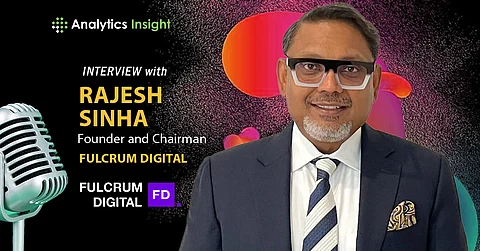

Artificial Intelligence (AI) is rapidly transforming industries, but Intelligence Augmentation (IA) is emerging as the next frontier. On Analytics Insight’s latest podcast, Priya Dialani and Rajesh Sinha, Founder and Chairman of Fulcrum Digital, explores how IA enhances human intelligence rather than replacing it. Fulcrum, with 1,500 global employees, is leading this shift with its FD RYZE platform, helping businesses integrate AI to amplify human decision-making and creativity.
He explained that IA goes beyond automation, creating intelligent systems that scale human insight. He shared his vision of a future where businesses use IA to drive smarter decision-making, productivity, and innovation. This discussion highlights how Intelligence Augmentation is shaping the future of business, emphasizing long-term value and growth.
Intelligence Augmentation (IA) is an innovative concept that sits between fully automated AI and human intelligence. IA is designed to boost human decision-making, creativity, and productivity rather than replacing human input altogether. This vision marks a shift from AI's traditional role of task automation to a more symbiotic relationship where AI amplifies human capabilities.
Rajesh Sinha outlined Fulcrum Digital’s evolution over the past 25 years, from providing solutions in portal content management to embracing AI-driven solutions. With 1,500 employees globally, the company is now a leader in AI-first innovation, notably through its FD RYZE platform. This transition has allowed Fulcrum to address AI maturity across healthcare, finance, insurance, manufacturing, and retail sectors.
Sinha emphasized that Fulcrum Digital’s AI journey has been driven by advancements in AI and the company’s commitment to delivering tailored solutions to its clients. "Intelligence Augmentation is about amplifying human intelligence to solve more complex problems, making businesses smarter, faster, and more efficient," said Sinha.
The podcast explored the distinct phases of AI development. He explained that the conventional AI era (spanning from the 1950s to 2019) revolved around machine learning and neural networks to analyze structured and unstructured data.
However, the emergence of large language models (LLMs) such as OpenAI's GPT ushered in the Intelligence Augmentation era after 2019. These models go beyond traditional AI by incorporating multimodal systems and memory capabilities, enhancing decision-making, productivity, and creativity.
“AI is the foundation. IA is the new layer amplifying everything intelligent,” Sinha said, adding that IA builds on the foundation of AI to amplify human potential.
Priya Dialani raised an important question regarding the common confusion between AI automation and IA. While both are integral to AI's role in the future, there is a significant distinction.
AI Automation: Focuses on replacing human tasks with machines to improve efficiency and reduce costs.
Intelligence Augmentation (IA): Instead of replacing humans, IA enhances their abilities, supporting smarter decision-making, more creativity, and improved problem-solving.
Sinha pointed out that the future lies in amplifying human intelligence. By using AI tools for IA, businesses can make better decisions, increase productivity, and create a more innovative and connected world.
Rajesh Sinha also discussed the concept of AI agents, which can be categorized as horizontal or vertical agents:
Horizontal Agents: These agents improve internal processes, such as employee workflows and operational efficiency.
Vertical Agents: These agents focus on achieving specific business outcomes, such as driving revenue or enhancing customer experience.
For example, in finance, AI agents can automate accounts payable, accounts receivable, and treasury tasks, eventually evolving into a "super-agent" with capabilities similar to that of a CFO. Similarly, in marketing, different AI agents can handle tasks such as SEO, content generation, and campaign analysis, all aligned towards business goals.
To explain how AI works, he used an analogy, likening AI to fabric. LLMs, he explained, are like powerful fabric—they hold immense potential but need to be tailored to specific business needs. Just as you wouldn’t wear fabric directly, businesses need to "cut and stitch" AI solutions to fit their unique requirements.
“You don’t wear fabric. You wear clothes made from it—tailored to your size and purpose,” Sinha explained.
Rajesh Sinha highlighted the importance of data integration for successful AI implementation. He introduced the Model Control Protocol (MCP), a new emerging standard similar to TCP/IP, which enables efficient communication between AI models across various systems.
MCP allows AI models to interact seamlessly with each other, driving smarter business decisions. He emphasized that AI should not operate in silos—connecting it to data sources directly can generate value without the need for additional layers, such as large data lakes.
Rajesh’s insight on AI’s future focused on the creation of an "AI fabric"—a unified, adaptable AI foundation that can support multiple agents across various business functions like HR, customer service, and finance. This approach avoids the siloed implementation of AI tools for isolated problems and instead focuses on building a holistic AI framework that enhances multiple business areas.
The concept of ROI is evolving in the AI era. It's no longer about short-term cost savings but about long-term value creation. Businesses should invest in resilient, intelligent systems powered by AI and IA, focusing on tailored solutions and reliable data structures instead of generic tools.
The episode emphasized a shift in AI adoption. The future isn’t about replacing humans with machines, but using AI to enhance human intelligence for smarter decisions. Businesses integrating IA will gain a competitive edge by boosting both workforce and technology.
Rajesh Sinha’s vision for AI and IA is clear: "It’s not just AI—it’s amplifying intelligence throughout every business layer." Companies can unlock innovation and increased productivity by aligning AI with business goals and leveraging IA.
